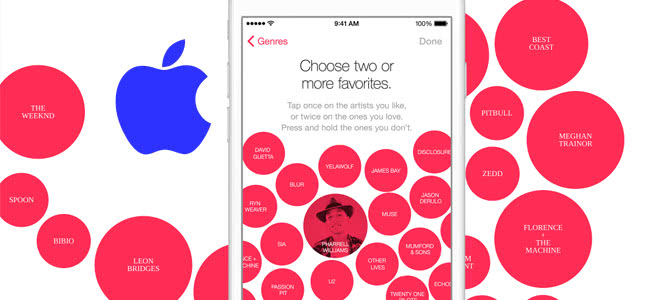If you can feel a certain electricity in the air today, that might be because Apple Music has officially launched. After months of eager anticipation, unrivalled hype, disputes with labels both major and independent, and even a public fallout with Taylor Swift, the game-changing streaming service is here.
While the Apple brand has built up more than enough brownie points with consumers, Apple Music kind of had the odds stacked against it. The company’s own reputation is actually part of the problem – they’ve released game-changer after game-changer and their head-first dive into streaming had to be something pretty impressive.
So did they pull it off? Is Apple Music the saviour of the music industry, set to revolutionise the business once again and not only make it profitable for artists, but change the entire music experience for listeners? Well, we’ve had a play here at the Tone Deaf and the answer is: it remains to be seen.
That said, Apple have a better shot than anybody, and the product itself is pretty spectacular. From its slick, instantly familiar interface, to the editorially-minded presentation, Apple Music is unlike any other streaming service or Apple product you’ve used before.
First things first, though, we did have a little trouble getting it installed on some of our devices. Getting Apple Music will mean updating to the latest version of Apple’s operating system on whatever device you’re hoping to use it on. This could potentially prove a problem to those with older hardware.
You’ll need to update your phone to iOS 8.4 and you’ll need to have the latest version of iTunes running on your laptop or desktop Mac. The silver lining here is that Apple Music is fully integrated into the latest version of iTunes, so you won’t have to install any additional software.
Another consideration is the fact that we could’t find Apple Music in the Google Play store, which makes sense, but it means Android users will have to stick with Spotify for now. Once you’ve got it installed, you’ll be asked to sign up for an Apple Music account.
As you may have read, the first three months of Apple Music are free, but after the trial period ends, you will be charged $11.99 for a single account or $16.99 for a family account. The pricing is pretty reasonable. The single account, for example, is no more and no less than a Spotify account.
“While it may sound counterintuitive, it’s hard to shake the feeling that you’re browsing through a real record store.”Important to keep in mind is the fact that once you sign on for the trial, you’re pre-committed to transitioning over to the paid service. It won’t even ask you for your credit card details since it’s linked to your iTunes account, which already has your financials.
Then, you’re off and running. Now, this is supposed to be a first impressions thing and we really will have to stick to just our first impressions, because there’s simply too many features to give a comprehensive overview of the service.
The product wastes no time in building your own unique musical profile and providing you with an experience that is solely yours and reflects your own personal tastes. That said, it’s never short on original suggestions and providing ideas for things you might also like, either.
You start off by nominating a range of preferred genres, clicking on them once if you like them and twice if you love them. For example, we double-clicked on ‘alternative’, ‘rock’, and ‘electronic’, and clicked once on ‘dance’ and ‘blues’.
You’re then asked to select from a small array of artists based on your genre preferences. The choices seemed to be localised, as we were given artists like Sarah Blasko, Nick Cave & The Bad Seeds, and Thy Art Is Murder. The selection was also remarkably eclectic, as it featured artists like Jamie xx and Robert Johnson.
After you’ve made your picks, you’re taken to the main screen of Apple Music. It’s definitely a plus that the service doesn’t waste too much time asking you questions about what you like and forcing you into menial data entry tasks, like selecting from a list of sub-genres.
In our case, we were presented with several playlists, including two comprised of “Deeper Cuts” from Arctic Monkeys and Hot Chip. Below this was a wide range of content, including suggestions for other artists. The service immediately integrates any music listened to into your profile.
For example, we decided to double check if Taylor Swift’s 1989 was on the service and when we returned to the main screen, her album Fearless had found its way into our ‘suggestions’.
One of the things that’s remarkable about the service is its interconnectivity. For example, selecting a curated playlist will also present a list of the artists featured in the playlist. Clicking on one of the artists takes you to their Apple Music profile where you can hear more of their music.
However, what we were really impressed by is the level of editorial acumen displayed in the program. For starters, while you may be overwhelmed by all the different features, you’re never confused about how to navigate the app. It’s instantly recognisable and basically follows an iTunes format.
This is essential, because there’s a lot to explore. One of our ‘suggestions’ was an introduction to Cut Copy (again, note the emphasis on local artists), while another was a playlist inspired by Flume’s influences. It gives the service a very curated feel.
While it may sound counterintuitive, it’s hard to shake the feeling that you’re browsing through a real record store. For example, while exploring the jazz section of the app, we noticed an ‘Essentials’ tag, which suggested albums like Miles Davis’ Kind of Blue and Oscar Peterson Trio’s Night Train.
This extends to the playlists, some of which are curated by music outlets like Rolling Stone and Vice. There’s your standard “’90s Alt” and “Electric Blues” playlists, but there’s also stuff like “Car-aoke!”, “Cooking with Bass”, and “Bros Just Wanna Have Fun”.
[include_post id=”450567″]
The service has personality, which makes it feel more like something you’re interacting with than simply using. One drawback is the fact that curated playlists can sometimes have tracks that are ‘missing’, since the rights may not be available in Australia.
It’s not just some Apple cash-grab, either. We actually struggled to find a single mention of iTunes within the app (FYI, if you click on the ellipsis icon next to a track, you can purchase it from there), which stands to reason, since you can already listen to the track in Apple Music.
Finally, there’s Beats 1, Apple’s much talked-about new global radio network. We tuned in just in time to hear St Vincent wrap up her show. She was in the middle of a conversation with a young US caller before spinning some David Bowie and Talking Heads. We haven’t turned it off since.
The schedule for the radio network is easily accessible and you can even access things like News and Talk, if that’s your thing. However, we did notice that all of the songs played on Beats 1 appear to be the censored versions, so don’t expect too many expletives.
Overall, Apple have managed to craft a pretty impressive product. Whether it will change the game remains to be seen, but we can see how the service could quickly become an integral part of how you get your music.




































